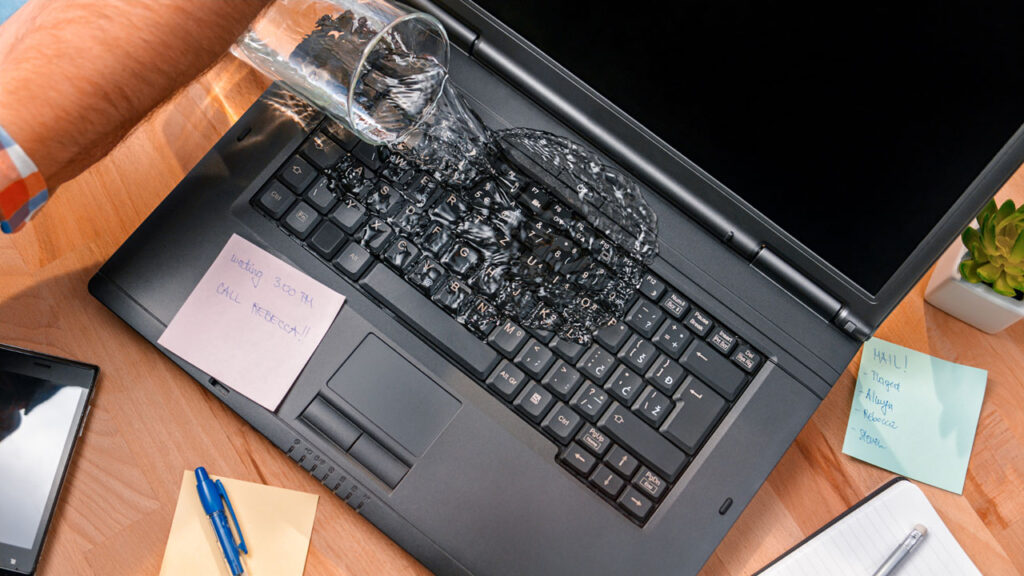We know of a problem that has plagued users for as long as computers have existed — spilled water on laptops. It’s a scenario that sends shivers down the spines of even the most composed of individuals. You’re sipping your coffee, going about your day, and suddenly, disaster strikes. That glass of water you had precariously perched on the edge of your desk tipped over and spilled all over your precious laptop.
If you’re reading this, chances are you’ve found yourself in this situation fairly recently, or you’re being proactive — just in case the inevitable occurs. Whatever the reason, don’t panic. While spilled water on your laptop is certainly not ideal, it’s not necessarily a death sentence for your device.
In this post, we will walk you through the steps you need to take to minimise the damage and hopefully restore your laptop to its former glory. So, if you’re staring at your laptop with water dripping out of it, or you’re just curious about what to do if the worst happens, keep reading to find out how to fix a laptop with water damage.
At a glance — what to do when water is spilled on your laptop
In case you’re caught in this predicament at the moment, there might not be enough time to read this entire guide, so here are the steps you should follow, which we will explain in more detail below:
- Shut down and unplug the device.
- Disconnect all peripherals and accessories.
- Remove as much water as you can from the surface.
- Open the laptop and remove components (if you can).
- Air dry for 2–3 days, reassemble and test.
- Call for a laptop repair service.
How to fix a laptop with water damage — detailed discussion
Dealing with water damage on your laptop can be a daunting experience, but it’s not the end of the world. While it’s true that water and electronics don’t mix well, there are some steps you can take to minimise the damage and, with a bit of luck, get your laptop back up and running again.
One important thing to remember is that time is of the essence. The longer your laptop is exposed to water, the greater the risk of irreversible damage. So if you’ve just spilled water on your laptop, don’t panic — but do act quickly.
It’s worth noting that the following steps are intended for situations where clean water (such as tap water) has been spilled on your laptop. If your computer has been exposed to salt water, soda or other liquids, the steps you need to take may vary.
1. Shut down and unplug the device
The first thing you need to do when you spill water on your laptop is to turn it off immediately. This is important to prevent any further damage to the internal components. Shut it down by pressing and holding the power button until it turns off. If plugged in, unplug it from the power source.
Do not try to save any unsaved work or files at this point, as attempting to do so can cause further damage to your device. Instead, your priority should be preventing any more electricity from flowing through it.
2. Disconnect all peripherals and accessories
Once you’ve turned off or unplugged your laptop, it’s important to disconnect all peripherals and accessories. These include:
- Mouse
- External keyboard
- Headphones
- Card readers
- Flash drives
- Wireless receivers (such as 2.4 Ghz and Bluetooth adapters)
- SD card (This is very easy to forget.)
- LAN cable
- Display cables — if connected (HDMI/VGA cables)
- DVD (On the off chance that your laptop still has a DVD drive)
3. Remove as much water as you can from the surface
Start by shaking your laptop gently to remove any excess water. Then, carefully tilt the laptop to drain any accumulated liquid from the keyboard or other parts. Be sure to rock it in different directions to ensure all the water is drained.
Next, use an absorbent towel or cloth to dry the surface of your laptop. Be sure to avoid using a paper towel or tissue, as these can leave behind lint or fibres that can get stuck in the crevices of your laptop.
Remember not to apply too much pressure when wiping down your laptop, as this can force water deeper into the internal components. Instead, use a gentle dabbing motion to soak up as much water as possible.
4. Open the laptop and remove components (if you can)
Before you proceed, remember that opening up your laptop can be tricky and may void your warranty. If you’re uncomfortable doing this, it’s best to take it to a professional repair service. It’s also worth mentioning that most manufacturer warranties don’t cover water damage on laptops anyway.
If you do decide to open it up, the first step is to remove the battery, only if it’s removable from the outside. If the battery is sealed within, as is the case with most modern units, skip this step and move on to the next.
Next, check your laptop’s user manual to see if it’s designed to be taken apart by the user. If so, follow the manual instructions to open the laptop. Typically, this involves unscrewing and popping open the case.
If your laptop is not meant to be opened by an everyday person, such as a Mac, it’s important to call a Mac repair specialist ASAP. Trying to open up your Mac yourself can cause more damage to your device.
Once you’ve opened it, look for any signs of water or dampness. Using your cloth, gently wipe any moisture you see. Next, if you have a decent amount of experience, take apart the laptop’s removable components. These include:
- Battery — This is usually connected via a thin wire to the motherboard and mounted on the case with screws.
- RAM — This memory stick is the easiest to remove, but a handful of laptop models have them soldered.
- SSD — This resembles the RAM, but it’s usually mounted using a screw on one end.
- Hard disk — If your laptop uses a hard disk, it’s usually the small, thin box that holds your data.
If you’re not comfortable removing any of these components, don’t.
5. Air dry for 2–3 days, reassemble and test
After you’ve done everything you can to remove the water from your laptop, let it air dry for at least 2–3 days. This will allow any remaining water to evaporate from your device.
Do not use a hair dryer or over-aggressive blowers to dry your laptop, as these can cause static or damage to the small components of the motherboard. Instead, leave your laptop in a well-ventilated area and let it air dry naturally.
While booting up your laptop to see if it’s working may be tempting, it’s best to resist this urge. Turning it on before it’s completely dry can cause irreparable damage to the internal components.
Once your laptop has air-dried for 2–3 days, you can reassemble it, turn it on and see if it’s working. If it’s not, it’s time for the final step.
6. Call for a laptop repair service
If you’ve tried all the steps mentioned above and your laptop still isn’t working, it’s time to call for professional help. Don’t wait until it’s too late — the longer you do, the greater the risk of permanent damage to your device.
At Jim’s I.T, we handle all computer issues, including water damage on laptops. We understand how essential your device is to you, which is why we offer same-day service to get you back up and running in no time. Plus, with our no-fix, no-fee policy, you can be confident that you won’t shell out anything if we’re unable to solve the problem.
Our technicians are fully insured and trained to handle all laptop repairs using only the highest quality parts to guarantee your device is repaired to the highest standard.
If you need laptop repair services, don’t hesitate to contact Jim’s I.T today. You can call, email or book a service directly on our website. We’re here to help you get back to work and stay connected.

